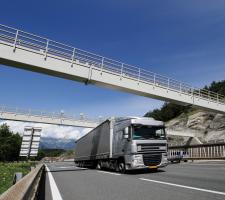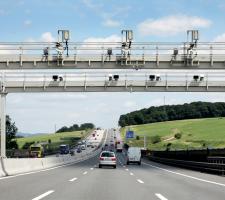
“Vendors’ proprietary solutions could be replaced by common solutions procured under competitive tendering processes” - Klaus Schierhackl
After much debate and delay, a unifying European Electronic Toll Service is now finally on the horizon, says ASFiNAG’s Klaus Schierhackl. Here, he talks with Jason Barnes about what that might mean.
Aworkable European Electronic Toll Service (EETS) which will allow truck drivers to travel across the continent and pay tolls using a single account and OnBoard Unit (OBU) was originally timetabled to be in place and operating by October of this year. A lack of urgency from some of the stakeholders involved in the formulation process and worries over perceived risk within the business case have resulted in delays but we can now expect to see a solution in operation for trucks within the next few years, according to Klaus Schierhackl, Chief Financial Officer of Austria’s national road operator,Unifying influence
Across Europe, 5.8GHz DSRC systems conforming to CEN TC 278 standards predominate and in theory interoperability across different tolling schemes shouldn’t be much of a problem – indeed, the main system producers and vendors will allude to their ‘interoperable’ systems whenever the issue is raised. The reality is somewhat less straightforward: discrete and often unconnected tolling scheme deployments which have their own account and account-handling set-ups and which as a result are ‘interoperable’ in little more than name.In order to cross Europe and make toll payments electronically, road users therefore have to procure multiple OBUs and manage multiple accounts. The concept behind the EETS, the proposed solution, is beguilingly simple: it would provide a common back office facility and an EETS service provider would take on the customer relations management function and deal with EETS customers. Tolling schemes’ back offices interface with the service provider’s back office and the service provider would then remediate payments across all the EETS member toll schemes.
Although the first priority in terms of outcomes from the EETS is an improved user experience which will reinforce the viability of more widespread tolling in the longer term, there will also be streamlined processes and lower costs for scheme operators. Beyond the immediate advantages which these will confer, there could well be a far more comprehensive revision of standards which affects everything from procurement processes to vehicle classifications. Over time, these will provide even further benefits to the user, according to Schierhackl.
“For road users, the main disadvantage of a delay in the EETS’s arrival is the absence of an ability to use a single OBU for all transactions. The technology is already there which can do this, however. For example, ASFiNAG currently uses OBUs from several sources including
“For scheme operators, the primary cost savings will relate to logistics and not having to distribute several different OBUs. But in time there will also be standardised back office systems, and across the board vendors’ proprietary solutions could perceivably be replaced by common solutions which are procured under competitive tendering processes. Vehicle classifications, meanwhile, have been driven by historical requirements and practices. It has led to fleet operators sometimes having to make decisions as to which vehicles to send on a particular task or route because of the charging considerations but we could yet see a situation where that becomes a past issue if, as is possible, efforts are made to unify classification standards.”
Existing bilateral agreements
ASFiNAG is already engaged in a number of bilateral agreements with road operators from other countries. These include Toll2GO which sees its users and those of Germany’s“The Scandinavian countries have a very good history of working together and a lot can be agreed on just a handshake, rather than having to sign contract after contract.
From a technical integration perspective – seeing how IT and so on can work together – this is a very good move for us.
We’re also looking to work with the Czech Republic, because the same underlying Kapsch technology is in use there, but doing so with some other countries is more difficult.
Poland, for example, has a mix of tolling schemes operated by the state and public-private partnerships. It has some considerable national interoperability issues to solve before it even considers looking to cooperate internationally.”
Differing aspirations
The Scandinavian link-up, whilst technologically useful for ASFiNAG, doesn’t necessarily represent big business, perhaps 10,000 vehicles a year according to Schierhackl, and that perhaps underlines the difference between political aspirations relating to Europe-wide tolling interoperability and commercial organisations’ more pragmatic approach. In part, it explains the lack of drive from some quarters to see the EETS implemented by the original October 2012 deadline – a situation reinforced by monopolistic thinking within the tolling sector which, perhaps, needs to be discouraged going forward. However, any criticism of the“When it comes to such matters, one thing I’m less convinced of is the potential success of the role of the EETS in delivering value-added services such as travel information,” Schierhackl adds. “Toll Collect, for example, always had big plans in this respect but I’m not sure that users will pay the toll scheme operators for navigation and other applications that they can already source elsewhere. Where I do see potential is in supplying services to drivers in their mother tongues. Two-thirds of truck drivers who pass through Austria don’t speak German, for instance. It would be a great step forward to be able to ‘speak’ to them in their own languages.”
Renewed vigour
Many considered the original go-live date to be overly optimistic but Schierhackl perceives a new vigour in the effort to deliver the EETS, driven in part by a collective realisation that a deadline has been missed and in part by the arrival of new faces, and a new enthusiasm, within the EC team responsible for delivery. There are also national projects coming to fruition which he feels reflect the spirit of the EETS and provide a potential model for other countries to follow. France’s Ecotaxe scheme falls into that category, he feels, because although it is a predominantly GNSS (satellite)-based solution it has a number of features which take careful account of interoperability with different concessionaire’s toll plazas.“The OBU solution is very interesting as it’s a hybrid which combines GNSS and a DSRC interface for Autostrade/Telepass facilities,” he continues. “The French procurement model looks to be very well constructed, too – there’s a tendering process and multiple suppliers of technology which I think is very healthy and bodes well for the future. It’s potentially a good model for other countries and regions to follow.”
Schierhackl is one of many across Europe who recognises the need to accelerate the standards definition process for GNSS-based tolling. Currently, there are only a few deployed systems. Germany and the Czech Republic have solutions for truck tolling on strategic roads (although the latter has been considering GNSS as a means with which to extend geographical coverage), whilst Slovakia, which operates a different, zonal charging regime, uses a hybrid GNSS/DSRC system. There is a greater level of knowledge and experience which has been sunk into DSRC and the appropriate standards if only by virtue of the fact that the technology has been around for longer; Schierhackl references the work done on interoperability by the EC and by
“In some respects, things are more complicated with GNSS because a lot more information is held in the OBU. But we’re 10 years farther down the road with DSRC and that means GNSS standards definition will happen much more quickly because we know the commercial features and so on which are required. What we need is the political will to make it happen but I think that that’s there, especially if one considers the decision process for European Union Directives such as 2004/52/EC on road tolling interoperability and 2009/750/EC, which defines the technical elements of the EETS. Of course, now we have to turn it into a reality…”
Addressing risk
ASFiNAG has been looking at the possibility of taking on the EETS service provider role. Concerns have been voiced over the level of risk for the EETS service provider but Schierhackl feels that these are somewhat misplaced or overstated.An element of the EETS service provider’s role is that it would be like a credit card company in that it would still be responsible to the individual toll schemes for payments even if these were not made by users.
In certain instances, even the individual liabilities could be sizeable – such as where a truck travels right across Europe with an inoperative OBU.
Notwithstanding the fact that OBU technology tends to be quite robust, if larger numbers of trucks with inoperable OBUs were to make the same types of journeys the result would be significant dents in revenues.
“Of course, we’ll only take on the role if it can be made profitable,” Schierhackl states.
“People talk about the example of a broken OBU but one can also cite some users’ unwillingness to pay – risk is but one element of tolling operations, and it exists now. But with that ‘increased’ risk comes more turnover and more business opportunities.”
Timetables for deployment
Original deployments timetables aside, he feels that the time is now finally right for the EETS.“I think that the notion that people actually needed the apparently ‘lost’ time to do their homework and get their heads round the complexities of how we actually deliver all this is a right one. But we can’t take too much longer or we’ll lose momentum. Three to five years from now, based on where we are now is, I think, a realistic proposition for truck traffic as this is more transcontinental in nature. Light and private vehicles tend to be more concerned with regional movements. I think that the timetable for these could and should be extended, that it should reflect such traffic’s more regional nature and that participation should be voluntary, not binding.”
The current shift of focus from bilateral projects towards Regional EETS (REETS)-type agreements is useful, according to Schierhackl, as these facilitate preparation for fair and transparent market conditions for a common European EETS market.
“ASFiNAG supports the EC’s initiative to organise such a REETS project, within the TEN-T framework, between Austria, Denmark, France, Germany, Italy, Poland and Spain. Pilot projects and project studies have proven very helpful to the establishment of an overall approach for an EETS framework. The REETS project should however have a clear goal of transitioning the pilot to normal commercial operation.”
He doesn’t see conflict arising from having different agreements and initiatives in operation at the same time.
“I think it’s a case of complementing, not competing. The analogy I’d make is with a travel agency: to be a successful business, it doesn’t have to offer all types of tour. It can specialise. Specialism promotes a more market-led approach and I think that’s healthy – the end beneficiary has to be the customer.”















